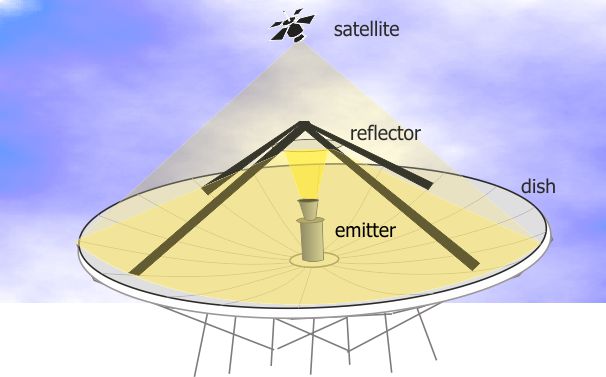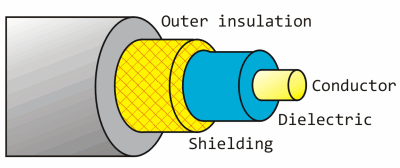Freesat reception - all about dishes
 Brian Butterworth published on UK Free TV
Brian Butterworth published on UK Free TV Satellite reception has both advantages and disadvantages compare with terrestrial (aerial) reception.
By using much higher frequencies (gigahertz, compared to terrestrial televisions megahertz) more transmission channels called transponders (the satellite equivalent of multiplexes) can be provided. For example, there are only six Freeview multiplexes, but Sky or Freesat users can access two hundred satellite transponders.
Aside from exceptional weather conditions (very heavy rain for example) digital satellite provides stable pictures and audio. Where Freeview transmitters are no more than 732 metres above sea level, the geostationary satellites used for television are 35,800,000 metres above the equator so reception is possible even where buildings, trees and hills make terrestrial reception impossible.

The downside of the transmitters being 22,300 miles up in the air is that the signals are very, very weak - so standard TV aerial is of little use. When the signals are sent to the satellites, huge dish transmitters are used to uplink the signal to the satellite. These are tens of metres from side to side, and feature an emitter that generates the signal, which is first bounced of a mirror (called a reflector) and then off the surface of the parabolic dish.

There are many satellites in the sky over the equator. Often these are in clusters over a particular position, for example there are four used for UK television are at 28.2 degrees east. There is another cluster over the 19.2 degrees east positions that are used for German television.
To receive these very weak signals from the satellite, it is necessary to use a dish for reception too. By using a reflective dish, this concentrates the signals onto a small device called a LNB. This is held in front of the dish by a metal arm.

The size of dish for reception is typically much smaller; often 60cm to 100cm in diameter, but the exact size depends upon the transmitting satellite transponder. To keep the transmission power levels down to levels that can be powered by the satellite's solar panels, each beam is focused on a particular area of the Earth's surface. If you are trying to receive the signal at the centre of this zone, a small dish is required. At the outer edges, you may need a 5 metre dish. Maps of these zones are provided by the satellite companies, and are called satellite footprints.
When the dish is installed it must be aligned carefully as the signal is very weak. The installer needs to know the inclination and the azimuth from the ground location to the satellite. If you install yourself you will find that there are markings on the dish that are used to point the dish in the correct position. It is important that the view of the satellite will not be blocked, so must take into account leaves growing on trees and potential building works.
For many people the LNB will have a single cable connected to it, however if you have Sky+ or a multi-room installation the LNB package will actually contain four receivers a quad-LNB. Unlike terrestrial television where you can split the aerial cable to feed more than one Freeview box or television set, with satelite reception you cannot. So, a Sky+ box with two receivers (so you can watch one thing and record another) has two cables connecting the box to the dish.
The cable that connects the dish to the receiver must be satellite grade cable. Whilst this looks superficially like the cable used to connect and aerial to a television, a higher grade cable is required for satellite reception.
Here is an image of a co-axial cable. This sort of cable is used to connect any type of receiving aerial to the reception equipment.

RG6, PF100 and PH100 are all types of coax cable that are suitable for the very weak signals that are received by a satellite dish. (The power is the same as you would receive from a one-bar electric heater on the moon).
The conductor in the centre passes the signals received from the dish to the set-top box. This is made from steel in RG6 cable, and from copper in the RF100 and PH100 types. This makes RG6 less suitable in the UK where rain can damage the cable.
The shielding is responsible for keeping unwanted external interference from damaging the signal. In the cheaper cable this will be a foil wrap, in better specified cables this is a braid (or mesh) of copper wires. The sheild in the RF100 covers 58% of the cable.
The non-conducting layer between the shield and the conductor is called the dielectric. This can be either a solid (RG6), foam (RF100) or air-spaced (PH100) dielectric. This makes the cables progressively more flexible (ie bendy without damage).
12:10 PM
At moment I have Virgin and want to change to Freesat but wondering if firstly will this be difficult to do and also what size dish would I need and if the area I live(North Kent) is a good reception area for Freesat?
Thank you for your time.
| link to this comment |
5:23 PM
maureen: Freesat can be received anywhere in the UK that has a reasonably clear South facing view of the Sky, and the dish need only be the standard Sky types seen used anywhere in Southern England, so you shouldnt have any problems whatsoever.
| link to this comment |
6:01 PM
maureen: Meant to also add, that if you are an e-bay user then just enter "Sky dish kits" and you will see a large range of them advertised around £20 / £30 or so, all you then require is someone to install it as the kits provide everything necessary for a normal installation.
An example of one seen on the link (e-bay Item number: 360402113820 in case the link doesn't work)
Satgear Sky HD/Freesat Zone 1 Satellite Dish Kit, 20m Cable, Quad LNB, Fixings | eBay
| link to this comment |
11:34 PM
I have sky tv but want to have tv in the bedroom also, I do not want to pay for multi room from sky, so if I buy a freesat box, can I just plug that straight into the existing sky dish, to receive free view, via a cable obviously, or will I have to get another dish installed?( There is a quad LNB already on the dish and I use two of the ports for my sky plus ). Very kind regards, Ian
| link to this comment |
9:00 AM
Ian Watts: If you already have a quad LNB on the dish then its simply a case of running another cable from one (any) of the two spare outlets, nothing else need be done.
| link to this comment |
4:30 PM
Hi
ihave one cable coming into house can i split it in order to run two sat boxes off it?
eric
| link to this comment |
5:10 PM
eric pounder: No, as when you change channels on a satellite box you are sometimes changing the polarity of reception, this being done by the box sending switching voltages back to the LNB, needless to say this being why the lead to an LNB cannot be shared with another box or these voltages are liable to clash with each other.
| link to this comment |
9:40 PM
If i were to fit up to 3 LNBs to my 80cm dish to receive signals from different satelites would i then have to get a special receiver to handle the extra satelite signals or would any satelite receiver do the job. Regards Jim.
| link to this comment |
4:07 PM
Hi,I have a dish with a single LNB receiving Freesat. The house is wired with 3 TV points in different rooms. The co-ax from the dish and the co-ax from each tv point are all built in to walls and floors and converge in a cupboard - one of the TV lines is connected to the dish co-ax, the other two are loose but they are interchnageable. I understand that because it is jointed I will lose signal but it is fine. I want to be able to have recievers in 3 rooms all on different channels. Changing the LNB or the dish is straightforward but can i use the existing built-in co-ax runs, so that i dont have to run new cable on the surface?
| link to this comment |
11:17 AM
Keith: You can't split the feed from an LNB. You'd need a multiple output LNB to the cupboard and 3 runs down, then a seperate feed off to each room.
| link to this comment |